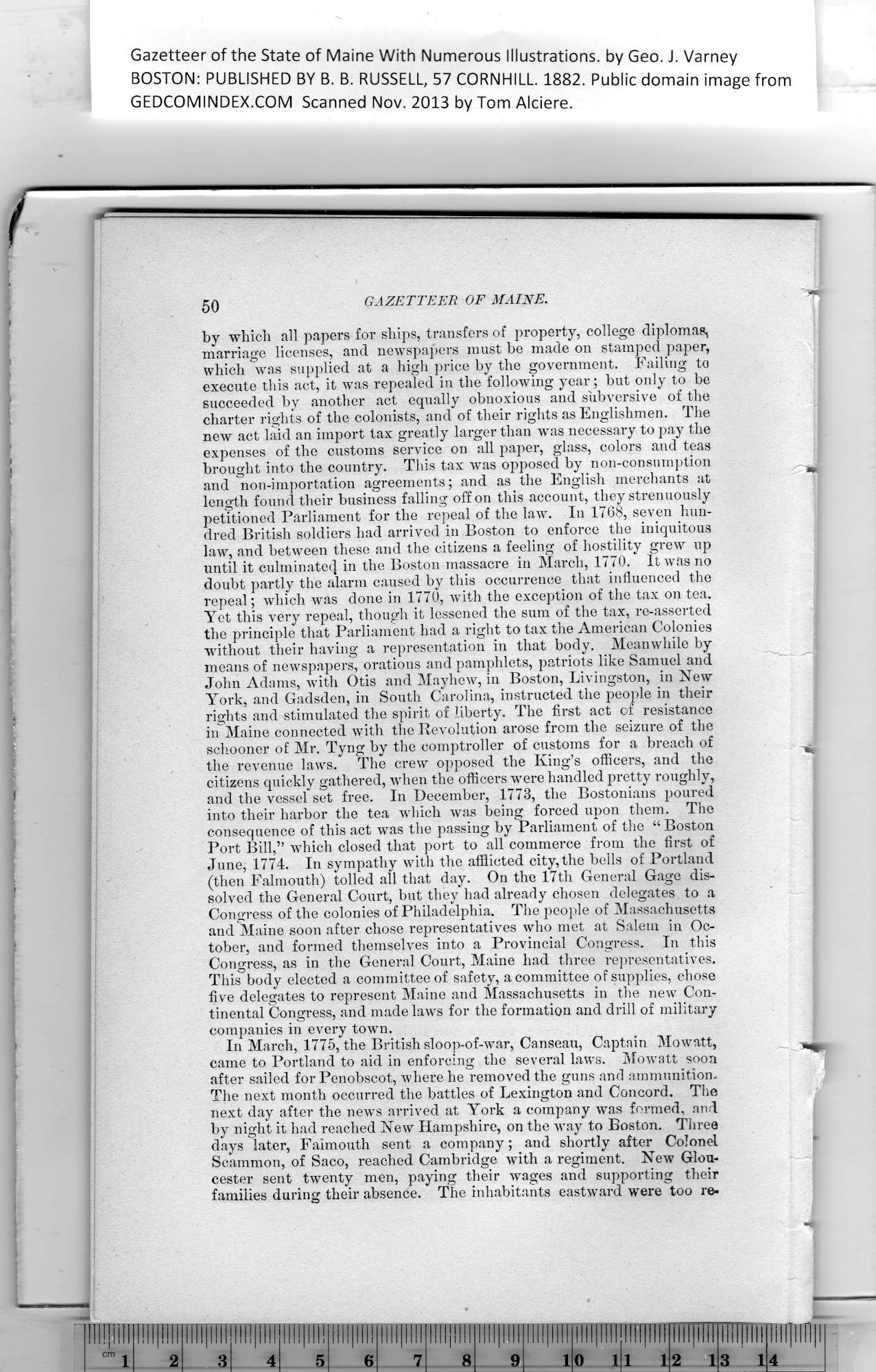|
Gazetteer of the State of Maine With Numerous Illustrations, by Geo. J. Varney
BOSTON: PUBLISHED BY B. B. RUSSELL, 57 CORNHILL. 1882. Public domain image from
5Q GAZETTEER OF MAINE.
by which all papers for ships, transfers of property, college diplomas,
marriage licenses, and newspapers must be made on stamped paper,
which was supplied at a high price by the government. Failing to
execute this act, it wTas repealed in the following year; but only to be
succeeded by another act equally obnoxious and subversive of the
charter rights of the colonists, and of their rights as Englishmen. The
new act laid an import tax greatly larger than w'as necessary to pay the
expenses of the customs service on all paper, glass, colors and teas
brought into the country. This tax was opposed by non-consumption
and non-importation agreements; and as the English merchants at
length found their business falling off on this account, they strenuously
petitioned Parliament for tbe repeal of the law. In 1768, seven hun-
dred British soldiers bad arrived in Boston to enforce the iniquitous
law, and between these and tbe citizens a feeling of hostility grew up
until it culminate4 in the Boston massacre in March, 1770. It was no
doubt partly the alarm caused by this occurrence that influenced the
repeal; which was done in 1770, with the exception of the tax on tea.
Yet this very repeal, though it lessened the sum of the tax, re-asserted
the principle that Parliament had a right to tax the American Colonies
without their having a representation in that body. Meanwhile by
means of newspapers, orations and pamphlets, patriots like Samuel and
John Adams, with Otis and Mayhew, in Boston, Livingston, in New
York, and Gadsden, in South Carolina, instructed the people in their
rights and stimulated the spirit of liberty. The first act of resistance
in’ Maine connected with the Revolution arose from tbe seizure of the
schooner of Mr. Tyng by the comptroller of customs for a breach of
the revenue laws. The crew opposed the King’s officers, and the
citizens quickly gathered, when the officers were handled pretty roughly,
and the vessel set free. In December’, 1773, tbe Bostonians poured
into their harbor the tea which was being forced upon them. The
consequence of this act was the passing by Parliament of the “Boston
Port Bill,” which closed that port to all commerce from the first of
June, 1774. In sympathy with the afflicted city, the bells of Portland
(then Falmouth) tolled all that day. On the 17th General Gage dis-
solved the General Court, but they had already chosen delegates to a
Congress of the colonies of Philadelphia. The people of Massachusetts
and Maine soon after chose representatives who met at Salem in Oc-
tober, and formed themselves into a Provincial Congress. In this
Congress, as in the General Court, Maine had three representatives.
This body elected a committee of safety, a committee of supplies, chose
five delegates to represent Maine and Massachusetts in the new Con-
tinental Congress, and made laws for the formation and drill of military
companies in every town.
In March, 1775, the British sloop-of-war, Canseau, Captain Mowatt,
came to Portland to aid in enforcing the several laws. Mowatt soon
after sailed for Penobscot, where he removed the guns and ammunition.
The next month occurred the battles of Lexington and Concord. The
next day after the news arrived at York a company was formed, and
by nigbt it had reached New Hampshire, on tbe way to Boston. Three
days later, Falmouth sent a company; and shortly after Colonel
Scammon, of Saco, reached Cambridge with a regiment. New Glou-
cester sent twenty men, paying their wages and supporting their
families during their absence. The inhabitants eastward were too re-
PREVIOUS PAGE ... NEXT PAGE
This page was written in HTML using a program written in Python 3.2
|
